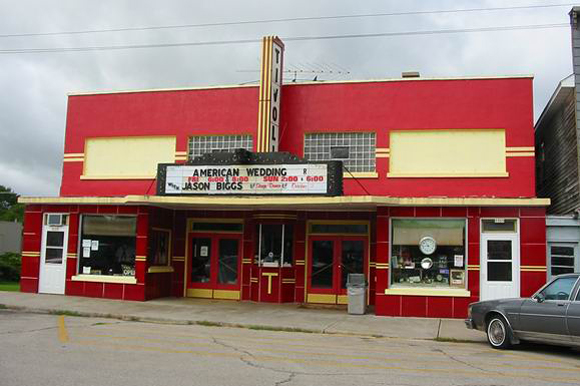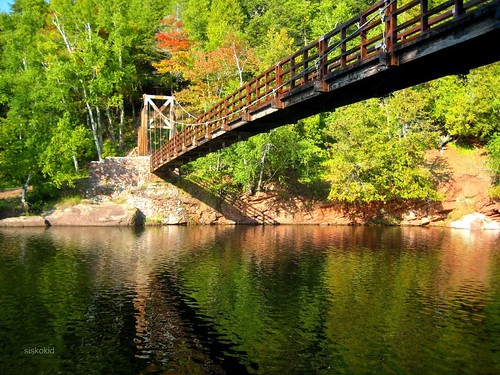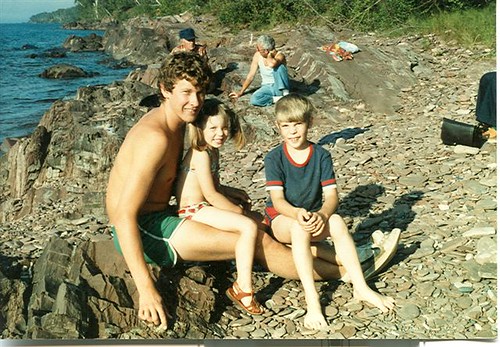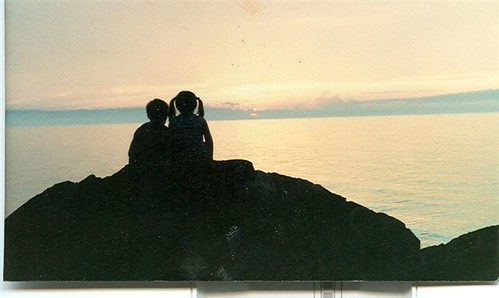Note: I’m going to try to write at least one biographical essay each month this year.
The Hunting Camp
When my family lived in Ironwood, in the early 1980s, we owned (or, I think, shared, with my dad’s brother) a tiny cabin way out in the woods north of town, about halfway between the farm and Lake Superior. We called it the “hunting camp,” and that name suited it better than “cabin” or, worse, “cottage.” The hunting camp wasn’t much of a building. It was a square one-room shelter with wood-framed walls (probably made from trees cut down to make a clearing for the structure) punctured by three small windows and one clattery door, which opened out onto a narrow porch.
The porch itself was mostly covered by firewood we fed to the big cast-iron stove that stood just inside the door, next to an equally old and wood-fired cooking stove. The two stoves were the dominant feature of the building’s interior. We cooled the hunting camp by opening the door. Northwoods weather being what it is, sometimes we had to use the stove for heat and the screen door for cooling in the same day.
As its climate-control features suggest, the hunting camp was far more rustic than a “cottage” in which a retired couple might want to retire or a family – like my cousins from Ohio – might spend a few summer weeks along the lake. Besides the stove, the hunting camp contained a bunk bed, a bigger regular bed, and a rickety kitchen table with three or four chairs around it (and an ashtray and pack of cards on it). I think there may have been a rug on the floor, and maybe some rough shelves near the stove. Was the floor wood or linoleum? I don’t remember, probably because the interior was always half-lit. The towering trees outside kept much light from coming in the windows. At night, a kerosene lantern over the table provided just enough room to play cards, but not enough – as I recall – to read a book while lying in your sleeping bag. You needed a flashlight for that, and for making the quick, spooky trip to the outhouse in back, under a towering evergreen that often sheltered porcupines. I remember seeing porkies up there, prickly even from a distance, slowly shifting from branch to branch.
The hunting camp was as remote as it was rustic. We could only way to get to the camp by driving down a long trail that started off as a very rough gravel road, mostly used by loggers, but turned into parallel tire tracks through the woods. This track was nothing a car could traverse, so we always took my dad’s gray International Harvester Scout, a sort of proto-SUV. Even the Scout got stuck more than once in a muddy low spot on the trail or blocked by a windfall tree. I would love to know how long we took to make the drive in from the road to the hunting camp – fifteen minutes? half an hour? an hour? I recall it seeming like a long but enjoyable ride, jouncing through the woods. Too, I would love to know the length of the trail. A mile or two? Ten? (Being then deeply fascinated with the military, I always thought it would be fun to rappel from a helicopter down to the camp. Nowadays, I would love to try to ski or bike in to the camp.)
Though I recall once having to turn around and head back home when the track was impassably muddy, we usually made it out to the hunting camp, where we’d unload the Scout and settle in for a few days, mostly spent – as you’d expect, given the camp’s spartan character – outside. A tiny brook – inevitably named “Mud Creek” and pronounced “mud crick” – ran along the edge of the camp’s clearing. At most shin-deep, the creek held no fish except for a few silvery minnow-sized things that were impossibly adept at holding themselves in place against the creek’s current. My sister and I loved to wade in the creek, squishing our feet down into the thick, cold mud along its bed.
And then there were the trees – seemingly endless forest, stretching out in every direction but always up. The track we used to drive in to the camp extended on beyond the campsite, so we could use it to walk further into the woods. I remember that such walks took us over a surprisingly big and sturdy log bridge. The bridge spanned a wider, deeper, and faster creek that I realize now must have connected somehow to Mud Creek. We fished off that bridge, catching fish that were big enough to cook and eat.
Somewhere around that bridge were trees that had strange S-shaped curves in them. My dad told me, at least a few times, that the trees had been kinked by bulldozers or logging trucks, and never straightened out. By the time I saw them, the bends were four or five feet off the ground, but I remember thinking they would be good chairs for giants.
Taking the road in the other direction, back toward the road, we drove past a couple other hunting camps, usually deserted. Once, the biggest one was occupied, and my dad, sister, and I dropped in. My dad must have known the owner, who was hosting a big all-male card game. I remember the players being very loud; they must have been very drunk, too. I also remember the owner/host cursing all the time as he played. I was old enough to recognize the f-word, so this visit must have occurred when I was in late elementary school or even junior high. I remember that the owner/host kept apologizing to my dad for cursing so much, what with my sister – maybe eight years old then – being right there.
Running away from the road were faint but discernible paths. I always thought of them as Indian trails, but of course they were probably deer paths. Following them, I never had any sense of being in danger of getting lost. I wonder if I’d feel that way now. My favorite paths ran north away from the hunting camp and to a big hill that we called, with what must have been Finlander irony, Mount Ilola. We climbed Mount Ilola a few times. From its peak, we could see exactly what you could see anywhere: the forest. I don’t think “Ilola” had any special meaning, but Googling the word now, I find this on Wikipedia:
Ilola (Swedish: Gladas) is a city district of Vantaa, Finland. It is located in the northern part of the administrative district of Koivukylä
Not very informative, except to indicate what sorts of people had the notion to put up shacks in the woods around the hill.
The hunting camp’s name was not a misnomer. In the fall, we did use it for hunting – mostly deer, I think. Others hunted in the woods too. I remember being at the camp one time when a group of bear hunters walked past, barely controlling a big group of hounds. I think my dad went out to talk to them for a few minutes, since that’s probably what you do when hunters cross your land. My mom was disgusted by hunting in general, but especially by the use of dogs to track and kill bears. Her basic anti-hunting argument – “What did those animals ever do to you?” – resonated with me after seeing the bearhunters.
That’s not to say I didn’t like hunting itself. I liked the few times I went with my dad into the woods to find deer, and I still recall the weird pleasure of actually bagging a buck once, somewhere in the general area of the hunting camp. Even more than hunting, I liked shooting guns, which was a big activity at the hunting camp, whether we were hunting anything or not. We would stand a few steps off the porch and fire our .22 rifle or, even better, our .22 pistol off into the woods, aiming mostly at empty cans and bottles. I usually had my BB guns along, too – a pistol and a rifle. These were less satisfying to shoot (less power, less noise) but I could fire them off without supervision as long as I still had BBs, which were sold, as I recall, in little containers that looked like milk cartons.
If walking around and shooting guns were the main outdoor activities, eating was the main indoor activity. My parents did most of our cooking on the cooking stove, and a bit on a green Coleman kerosene stove that we hauled in with us. I remember being slightly amazed by the fact that my parents could toast bread simply by buttering it and laying it in a pan on top of the stove, right next to the bacon. It tasted awfully good.








